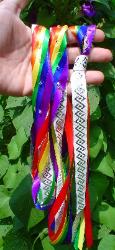Handfasting rituals are popular additions to a traditional wedding ceremony due to their strong cultural and historical backgrounds. They also provide a surprise for the guests, which keeps the ceremony more interesting.
Handfasting rituals can be performed as an engagement, or as an addition to a more traditional wedding service. The expression of “tying the knot” came from this early Celtic marriage ritual.
Handfasting was customarily a very simple ceremony, the bride and groom faced each other and joined right hand to right hand and left hand to left hand and were bound by a ceremonial wrap or rope. In Scotland the cloth was usually a piece of the family tartan representing the bride or groom’s clan or family group. If you are planning a Celtic, or medieval style wedding,
Handfasting is a splendid ritual to add to your traditional ceremony and vows.
One of the nice aspects to handfasting is that it is also a declaration of intent, where the bride and groom clearly state that they are marrying of their own free will, as well as stating their vows.
There are many variations when it comes to Handfasting ceremonies. Some use just one single silk cord or a clan’s tartan; others use a number of cords or sashes.

